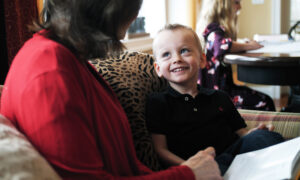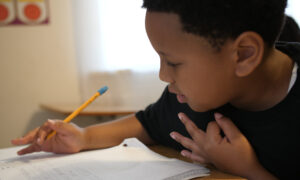“What should we do tonight?” one of my college friends asked on a rainy Saturday night in 1977. After a few rounds of “I dunno, wudda you wanna do,” someone plucked the campus newspaper from his backpack and looked at the movie ads. (For you millennials out there, that’s the mid-twentieth century analog version of pulling out your smartphone and googling “movies near me.”)
The paper had ads for four movies. One of them was called—Star Wars.
“What’s Star Wars about?” one of my friends asked. “Sounds like science fiction.”
Blissfully ignorant, we made our way to the fancy new tri-plex out on the edge of town. As the lights went down, we were immediately transported to “a long time ago in a galaxy far, far away . . . .” And we were transfixed—from the now-iconic opening crawl right through to the closing celebration at the Rebel base.
I remember vividly that magical night as if it were yesterday. It astounds me to realize that it was forty-four years ago.
 Hearkening back to 1977, when Star Wars first hit theaters, can give us some important perspective because the year 1977 is a pretty good starting point for the birth of the modern homeschooling movement. According to the Oxford English Dictionary, the first time the word “homeschool” was printed in the modern sense was in 1981 in the New York Times: “A few parents appear to be thriving on the home-school arrangement. One mother said she ‘learned as much as her children did.’”
Hearkening back to 1977, when Star Wars first hit theaters, can give us some important perspective because the year 1977 is a pretty good starting point for the birth of the modern homeschooling movement. According to the Oxford English Dictionary, the first time the word “homeschool” was printed in the modern sense was in 1981 in the New York Times: “A few parents appear to be thriving on the home-school arrangement. One mother said she ‘learned as much as her children did.’”
A lot has happened since then. From being almost completely unknown in 1977, homeschooling has become an accepted, mainstream educational option, just one more choice on the educational menu. From a number statistically difficult to distinguish from zero in 1977, conservative estimates put the number around 3 million children being homeschooled in January of 2020. (More about 2020 in a bit.)
Think of that. Forty-three years to go from zero to 3 million.
 What happened during those 43 years? People today often don’t realize that states like Texas, Michigan, Iowa, North Dakota, and many others prosecuted parents for homeschooling, or made it exceedingly difficult to do unless one of the parents had a teaching certificate. A reporter for New Yorker magazine recently asked me to recount some history of homeschooling for a story she is writing about Black homeschoolers in Detroit. She was genuinely surprised to learn that homeschoolers were regularly prosecuted in Michigan, which ended when the Supreme Court of Michigan threw out those prosecutions as unconstitutional in 1993 in the case of People v. DeJonge.
What happened during those 43 years? People today often don’t realize that states like Texas, Michigan, Iowa, North Dakota, and many others prosecuted parents for homeschooling, or made it exceedingly difficult to do unless one of the parents had a teaching certificate. A reporter for New Yorker magazine recently asked me to recount some history of homeschooling for a story she is writing about Black homeschoolers in Detroit. She was genuinely surprised to learn that homeschoolers were regularly prosecuted in Michigan, which ended when the Supreme Court of Michigan threw out those prosecutions as unconstitutional in 1993 in the case of People v. DeJonge.
In those 43 years, homeschooling has gone from being viewed as fringy and illegal, to being unquestionably legal and mainstream. That did not happen by accident.
As the number of families desiring to homeschool grew, a genuine social movement emerged. There were pioneers—those willing to risk and endure great adversity to accomplish a goal driven by deep conviction.
There were movement leaders—like Home School Legal Defense Association founder Mike Farris, who began defending homeschooling families in court in 1983—pro bono. And movement organizations sprang up in almost every state. They supported homeschooling families and worked diligently to change the state laws to permit homeschooling. Throughout the 1980s and 1990s, through court cases and legislative activism—and through sheer numerical growth—homeschooling became unquestionably legal state by state.
And over the last 20 years, antiquated homeschooling laws have been updated to reflect both modern technology and the success of homeschooling as an educational model. Barriers to college admission, military enlistment, and career opportunities have been rolled back—and are still being rolled back. There is still work to be done to ensure that homeschooled high school graduates are treated fairly when applying for certain jobs or trade schools. But the legal landscape today is one of homeschool freedom.
Then 2020 happened. Boy did it happen.
By January of 2020, homeschooling had 3 million children. By January of 2021, that number had more than doubled, maybe even tripled. As the COVID-19 pandemic caused unprecedented disruptions across many sectors, the U.S. Census Bureau began surveying households to see what people were doing in response to the pandemic, including widespread public-school closures. According to HSLDA’s crack research department, estimates show that as many as 10 million children may be homeschooling today.
From zero to 3 million in forty years, then from 3 million to 10 million children in a single year. That is staggering in scope and pregnant with possibilities.
We do not know what these newcomer families will do once the pandemic recedes. But here is what we do know. The struggle for homeschool freedom that began over forty years ago laid the groundwork that created a viable safe harbor for many families to serve their children.
 Anecdotally, many are saying they will never go back. Homeschooling allowed them to tailor the education their children received. Because many parents also found themselves working at home while their children were home, schooling, they were present during the eureka learning moments when their children made a breakthrough. Many learned that this time together is precious and joyful and fulfilling for moms and dads in addition to the kids.
Anecdotally, many are saying they will never go back. Homeschooling allowed them to tailor the education their children received. Because many parents also found themselves working at home while their children were home, schooling, they were present during the eureka learning moments when their children made a breakthrough. Many learned that this time together is precious and joyful and fulfilling for moms and dads in addition to the kids.
Noted psychology professor Peter Gray, conducted a large-scale, demographically representative survey several weeks after schools closed. He recently summed up his initial findings on his Psychology Today blog: “But then parents began to see their kids through new eyes, and, for the most part, they liked what they saw; and children began to see that their parents really cared for them—as people, not as grades on a report card.”
A lot has changed since Luke Skywalker and Princess Leia first graced the silver screen in 1977. Among the more significant societal changes have been the birth, growth, and success of homeschooling and the homeschooling movement.
At the core of the movement has been a commitment to homeschool freedom. That commitment by many families, movement leaders, movement organizations, and freedom-loving policymakers, over many decades, has brought us to today, where many millions have benefitted.
Homeschool freedom is good for the country, good for families, and especially good for children.
 Since joining HSLDA to lead the litigation team in 2001, Jim Mason has represented homeschooling families in a wide range of challenging situations and has set precedents that have expanded freedom for the homeschool community. Under Jim’s leadership, HSLDA’s 4th Amendment litigation work has changed the way three states (North Carolina, Pennsylvania, and New Mexico) approach social services investigations. In Wilson v. Russo, HSLDA won a $700,000 settlement for our client, a single parent whose children were seized by a rogue child protective services investigator.
Since joining HSLDA to lead the litigation team in 2001, Jim Mason has represented homeschooling families in a wide range of challenging situations and has set precedents that have expanded freedom for the homeschool community. Under Jim’s leadership, HSLDA’s 4th Amendment litigation work has changed the way three states (North Carolina, Pennsylvania, and New Mexico) approach social services investigations. In Wilson v. Russo, HSLDA won a $700,000 settlement for our client, a single parent whose children were seized by a rogue child protective services investigator.
Jim was instrumental in litigating the 2008 California case Jonathan L., in which a state appellate court reversed its previous ruling that homeschooling was illegal. This put an end to years of controversy over the legal status of homeschooling in California and set a precedent that affects other states as well.
HSLDA is sponsoring sessions live and in person at FreedomFest July 21-24 at the Rushmore Plaza Civic Center in Rapid City South Dakota.

